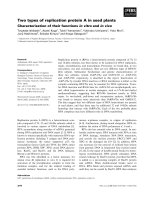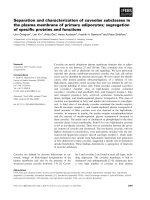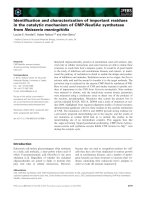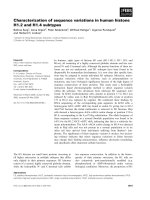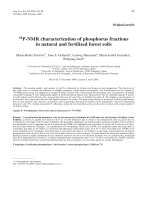DUS characterization of germplasm accessions in foxtail millet (Setaria italica (L.) Beauv.)
Bạn đang xem bản rút gọn của tài liệu. Xem và tải ngay bản đầy đủ của tài liệu tại đây (661.75 KB, 13 trang )
Int.J.Curr.Microbiol.App.Sci (2019) 8(2): 2410-2422
International Journal of Current Microbiology and Applied Sciences
ISSN: 2319-7706 Volume 8 Number 02 (2019)
Journal homepage:
Original Research Article
/>
DUS Characterization of Germplasm Accessions in
Foxtail Millet (Setaria italica (L.) Beauv.)
K. Amarnath1*, A.V.S. Durga Prasad1 and C.V. Chandra Mohan Reddy2
1
Department of Genetics and Plant Breeding, Agricultural College,
Mahanandi -518 502, A.P., India
2
RARS, Nandyal - 518 501, A.P., India
*Corresponding author
ABSTRACT
Keywords
DUS Descriptors,
Foxtail millet,
Qualitative traits,
Quantitative traits,
Morphological
characterization
Article Info
Accepted:
18 January 2019
Available Online:
10 February 2019
In the present study, 50 germplasm accessions of foxtail millet [Setaria italica (L.) Beauv.]
were evaluated based on DUS descriptors for six morphological (qualitative) traits viz.,
plant growth habit, plant pigmentation at auricle, inflorescence shape, inflorescence
compactness, lobe compactness, seed colour and six quantitative characters viz., flag leaf:
blade length (cm), flag leaf: blade width (cm), peduncle length (cm), peduncle exertion,
panicle length (cm) and plant height at maturity (cm). All the germplasm accessions were
characterized into different groups based on each character. The results revealed
significant variation among the germplasm accessions for all the characters studied
implying that morphological characterization of the foxtail millet germplasm accessions
had enormous genetic diversity that will assign them key diagnostic features facilitating
selection process, enabling the plant breeders in proper documentation to protect them
from any possible infringement.
Introduction
Foxtail millet (Setaria italica (L.) Beauv.), an
annual autogamous diploid (2n = 18) small
millet is a photosynthetically efficient C4
monocot belonging to the family, Poaceae.
Out of
80 k ha. grown in India, this crop is
cultivated in an area of 51 k ha. in Andhra
Pradesh with a productivity of 945 kg ha-1
compared to national terms of 900 kg ha-1
(Annual report, 2016-17). This millet grains
offers an excellent source of quality proteins
(leucine and methionine), β-carotene,
minerals (Ca, Fe, K, Mg and Zn),
antioxidants, dietary fibre, phytochemicals,
vitamins (thiamine, riboflavin and niacin) and
have low glycemic index, a requisite for
healthy human diet
(Murugan and
Nirmalakumari, 2006). Besides, its small
genome size of ~ 515 Mb (Li and Brutnell,
2011) provides ample scope for molecular
and genetic research as a ‘model crop’ to
understand deeper insights into plant biology.
The ‘Protection of Plant Varieties and
2410
Int.J.Curr.Microbiol.App.Sci (2019) 8(2): 2410-2422
Farmers’ Right Act, 2001 (PPV & FR Act,
2001) of India encourages public/private
investment in research and development of
new plant varieties by giving protection to the
new plant genotypes against unauthorized
multiplication of seeds or propagating
materials for a specific period. In addition, the
act insists on DUS characterization of extant,
farmers and new varieties and recommends
the registration of varieties for atleast any one
specific novel character.
The new foxtail millet genotypes will be
protected under the PPV & FR Act after
confirming DUS testing through the
comparison of new and existing varieties in
similar environment for a set of
morphological characters. Characterization of
these diverse germplasm accessions for their
morphological characteristics holds immense
potential for their objective utilization in the
breeding programme. Further they serve as an
indispensable tool in selecting varieties or
lines based on agronomical, morphological,
genetic
or
physiological
characters.
Therefore, the present investigation was
conducted to characterize the foxtail millet
germplasm accessions for selected DUS
characters, yield and yield attributing traits.
season at RARS, Nandyal. Standard cultural
and agronomic practices were adopted to raise
a healthy crop. The experimental field was
protected from bird damage during grain
filling stage by installing bird scarers. Based
on attainment of harvestable maturity, the
foxtail millet germplasm accessions studied
were harvested at varied intervals (Table 1).
Data recording and analysis
The observations based on DUS descriptors
for six morphological (qualitative) traits
(Table 2) viz., plant growth habit, plant
pigmentation at auricle, inflorescence shape,
inflorescence compactness, lobe compactness,
seed colour and six quantitative characters
(Table 3) viz., flag leaf: blade length (cm),
flag leaf: blade width (cm), peduncle length
(cm), peduncle exertion, panicle length (cm)
and plant height at maturity (cm) were
recorded for each germplasm accession on
five randomly selected plants per replication.
The range, mean and coefficient of variations
for six quantitative characters were computed.
Results and Discussion
Qualitative descriptor
Materials and Methods
Plant materials and field trails
The experimental material for the present
study comprised of 50 foxtail millet
germplasm accessions chosen from 1038
accessions
maintained
at
Regional
Agricultural Research Station (RARS),
Nandyal, Andhra Pradesh, India. These
germplasm accessions were raised in a field
trail of randomized complete block design
(RCBD), replicated thrice with a plot size of
13 m × 15 m per each germplasm accession,
with a spacing of 22.5 cm and 10 cm between
rows and plants, respectively during kharif,
Characterization of the qualitative traits
revealed a wide variation among the
accession
(Table 4). Each descriptor is
categorized
based
on
morphological
descriptor and is presented as key for
identification (Flow charts) (Fig. 3).
Plant growth habit
In the present study two kinds of Plant growth
habit was noticed: Among 50 Italian millet
germplasm accessions, Erect was dominant
(41) over Decumbent (9). Similar results were
reported by Reddy et al., (2006), Reddy et al.,
(2009) for erect type of growth habit (Fig. 1).
2411
Int.J.Curr.Microbiol.App.Sci (2019) 8(2): 2410-2422
Plant pigmentation at auricle
Quantitative descriptor
Two types of plant pigmentation at auricle
was occurred in Italian millet germplasm
accessions and categorized as Pigmented
types and Non-Pigmented.
Range, mean and coefficient of variations for
six quantitative characters were shown in
Table 5 and Figure 2.
Flag leaf: Blade length (cm)
The Non-pigmented types (42) were dominant
over Pigmented types (8). Similar result was
obtained by Banu et al., (2015) for this trait
Majority (44) of the germplasm accessions
exhibited medium while the remaining were
long for the trait, flag leaf blade length.
Inflorescence shape
In the present study, inflorescence shapes of
genotypes were categorized into three groups
viz., oblong (27), cylindrical (14) and
pyramidal (9). Similar classification was
reported by Radha et al., (2014) and Ahmed
et al., (2017) for this trait.
This result is in accordance with the findings
of Ahmed et al., (2017) and Nehra et al.,
(2017).
Flag leaf: Blade width (cm)
Inflorescence compactness
Medium blade width for flag leaf was
observed in all the germplasm accessions.
Similar finding was also reported by Ahmed
et al., (2017).
Based on this trait, the germplasm accessions
were grouped into three types i.e., loose (3),
medium (44) and compact (3).
Peduncle length (cm)
The results found were in conformity with the
findings of Reddy et al., (2006), Radha et al.,
(2014).
All the germplasm accessions were
characterized either medium (28) or long (22)
for this trait.
This result is in consonance with the findings
of Reddy et al., (2006) and Amgai et al.,
(2011).
Lobe compactness
Based on the lobe compactness, germplasm
accessions were grouped into three classes
loose (3), medium (44) and compact (3).
Similar results were obtained by Radha et al.,
(2014), Ahmed et al., (2017).
Seed colour
Based on seed colour, the germplasm
accessions were categorized as light yellow
(34), yellow (13), white (1), orange (1) and
red (1). Contrarily, Reddy et al., (2006),
Radha et al., (2014) and Banu et al., (2017)
reported that yellow seeds were more
dominant.
Peduncle exertion
Among the germplasm accessions studied, the
trait peduncle exertion was observed to be
either long (47) or short (03). Similar result
was reported by Amgai et al., (2011) for this
character.
Plant height at maturity (cm)
Most of the germplasm accessions were tall
(44) accessions while few were medium (6).
Similar result was obtained by Nehra et al.,
(2016).
2412
Int.J.Curr.Microbiol.App.Sci (2019) 8(2): 2410-2422
Table.1 Details of 50 foxtail millet germplasm accessions utilized for study
S. No
1
2
3
4
5
6
Germplasm accession
SiA 3085
SiA 3156
SiA 3221
SiA 3322
SiA 3327
SiA 3328
Parentage
Selection from SiA 2644 from farmers field
Pureline selection from SiA 2871
SiA 3075 x ISC 379
Selection from ISC 1161
Selection from ISC 1076
Selection from ISC 748
7
SiA 3333
Selection from ISC 909
8
9
SiA 3335
SiA 3340
Selection from ISC 745
Selection from ISC 362
10
SiA 3346
Selection from ISC 160
11
SiA 3347
Selection from ISC 1162
12
SiA 3354
Selection from ISC 18
13
SiA 3355
Selection from ISC 869
14
SiA 3363
Selection from ISC 1134
15
16
17
SiA 3364
SiA 3367
SiA 3369
Selection from ISC 267
Selection from ISC 1118
Selection from ISC 1177
18
19
20
21
22
23
SiA 3375
SiA 3376
SiA 3377
SiA 3378
SiA 3381
SiA 3382
Selection from ISC 838
Selection from ISC 796
Selection from ISC 254
Selection from ISC 525
Selection from ISC 398
Selection from ISC 403
24
25
26
27
28
29
30
31
32
33
34
35
36
37
38
39
40
41
42
43
44
45
46
47
48
49
50
SiA 3383
SiA 3384
SiA 3386
SiA 3389
SiA 3390
SiA 3392
SiA 3393
SiA 3394
SiA 3395
SiA 3396
SiA 3397
SiA 3398
SiA 3399
SiA 3400
SiA 3401
SiA 3403
SiA 3404
SiA 3405
SiA 3407
SiA 3447
SiA 3381
Srilakshmi
Suryanandi
Prasad
Narasimharaya
Krishnadevaraya
ISC 347
Selection from ISC 200
Selection from ISC 480
Selection from ISC 907
Selection from ISC 507
Selection from ISC 828
Selection from ISC 717
Selection from ISC 375
Selection from ISC 792
Selection from ISC 931
Selection from ISC 846
Selection from ISC 917
Selection from ISC 179
Selection from ISC 237
Selection from ISC 388
Selection from ISC 735
Selection from ISC 842
Selection from ISC 195
Selection from ISC 364
Selection from ISC 96
Selection from ISC 1704
Selection from ISC 936
Pureline selection from local
Pureline selection from SiA 1244
Selection from Dronachalam village
SiA 805 x SiA242
SiA 326 x SiA242
ICRISAT gene bank
2413
Int.J.Curr.Microbiol.App.Sci (2019) 8(2): 2410-2422
Table.2 Characteristics of six morphological traits
S.No
Character
Status
1
Plant growth habit
2
Plant: Pigmentation at auricle
3
Inflorescence: Shape
4
Inflorescence Compactness
5
Lobe compactness
6
Seed: Colour
Stage of Observation
Erect
Decumbent
Absent
Present
Oblong
Pyramidal
Cylindrical
Loose
Medium
Compact
Flowering
Flowering
Flowering
Dough
Loose
Medium
Compact
Orange
Red
Yellow
Light Yellow
Straw
Maturity
Maturity
Table.3 Characteristics of six quantitative characters
S.No
1
2
3
4
Character
Flag leaf: Blade length (cm)
Flag leaf: Blade width (cm)
Peduncle length (cm)
Peduncle exertion
4
Plant height at maturity
6
Panicle length
Status
Short (<20)
Medium (20-35)
Long (<35)
Narrow (<1.5)
Medium (1.5-3.0)
Long (>3.0)
Short (<20)
Medium(20.0-30.0)
Long (30.0-40)
Very long (>40)
Short (<20)
Medium(20.0-30.0)
Long (30.0-40)
Very long (>40)
Short (<80)
Medium (80-120)
Compact (> 120)
Short (<10)
Medium(10.0-15.0)
Long (>15)
2414
Note
1
9
Stage of Observation
Flowering
1
Flowering
9
1
Flowering
3
5
3
Dough
5
7
3
5
7
Maturity
-
Maturity
Int.J.Curr.Microbiol.App.Sci (2019) 8(2): 2410-2422
Table.4 Morphological characterization in 50 foxtail millet germplasm accessions
S.No.
Name of the descriptor
Descriptor state
1
Plant growth habit
2
Plant pigmentation at auricle
Erect
Decumbent
Pigmented
41
9
8
Frequency
(%)
82
18
16
Non Pigmeneted
42
84
Oblong
Pyramidal
Cylindrical
Loose
Medium
Compact
Loose
Medium
Compact
Yellow
White
Orange
Red
Light Yellow
Yellow
27
9
14
3
44
3
3
44
3
13
1
1
1
34
13
54
18
28
6
88
6
18
72
10
26
2
2
2
68
26
3
Inflorescence shape
4
Inflorescence compactness
5
Lobe compactness
6
Seed colour
No. of accesssions
Table.5 Quantitative variations for six descriptors of foxtail millet germplasm accessions
Descriptors
Mean
Range
CV (%)
Flag leaf: Blade length (cm)
32.19
25.60-37.80
9.97
Flag leaf: Blade width (cm)
1.86
1.29-2.14
7.42
Peduncle length (cm)
29.80
23.10-37.73
7.38
Peduncle exertion
15.19
9.77-23.00
16.32
Plant height at maturity (cm)
131.87
101.73-153.33
6.31
Panicle length (cm)
18.07
10.55-22.10
12.34
2415
Int.J.Curr.Microbiol.App.Sci (2019) 8(2): 2410-2422
Fig.1 Qualitative characters
1.
Plant growth habit
Erect
2.
Decumbent
Plant pigmentation at auricle
Pigmented
3.
Non- pigmented
Inflorescence shape
Cylindrical
Oblong
2416
Pyramidal
Int.J.Curr.Microbiol.App.Sci (2019) 8(2): 2410-2422
4.
Inflorescence compactness
Loose
5.
Medium
Lobe compactness
Loose
6.
Compact
Medium
Compact
Seed colour
Orange
Red
Light Yellow
2417
Yellow
White
Int.J.Curr.Microbiol.App.Sci (2019) 8(2): 2410-2422
Fig.2 Quantitative characters
1. Flag leaf: Blade length (cm)
3.
Peduncle length (cm)
2.
Flag leaf: Blade width (cm)
4. Peduncle exertion
5. Panicle length (cm)
6. Plant height at Maturity (cm)
Medium (80-120 cm)
Tall (>120 cm)
2418
Int.J.Curr.Microbiol.App.Sci (2019) 8(2): 2410-2422
Fig.3 Morphological key for identification of 50 Italian millet germplasm accessions
2419
Int.J.Curr.Microbiol.App.Sci (2019) 8(2): 2410-2422
2420
Int.J.Curr.Microbiol.App.Sci (2019) 8(2): 2410-2422
Panicle length (cm)
For the trait, panicle length, majority of the
germplasm accessions reported long (46)
while only few (4) were medium. Similar
results were noted by Nirmala kumari et al.,
(2010) and Nehra et al., (2016) for this trait.
In conclusion, morphological characterization
of 50 foxtail millet germplasm accessions for
six qualitative traits revealed existence of
ample polymorphism for the characters. It
was observed that for plant growth habit,
erect was dominant over decumbent; for plant
pigmentation at auricle, non-pigmentation
was dominant over pigmentation; for
inflorescence shape, oblong was dominant
over cylindrical and pyramidal; for
inflorescence compactness, medium was
dominant over compact and loose; for lobe
compactness, presence was dominant over
2421
Int.J.Curr.Microbiol.App.Sci (2019) 8(2): 2410-2422
absence; for seed colour; yellow was
dominant over light yellow, orange, red and
white. Data analysis for six quantitative traits
inferred medium for flag leaf blade length,
flag leaf blade width, peduncle length; long
for peduncle exertion and panicle length; tall
for plant height. Based on the findings, it can
be concluded that morphological DUS
descriptors can be effectively used for
identification, documentation and grouping of
varieties along with their use in registration
and unambiguous identification in the field.
The morphological descriptors are of
immense help to the plant breeders for
selecting desirable genotypes easily through
visual assessment and further the highly
contrasting germplasm accessions for a
particular trait can be utilized to develop
mapping populations in order to map QTLs.
Although DUS testing has been done
precisely to provide diversity assessment at
morphological level but there remains a
further scope to validate the findings through
diversity analysis at molecular level as
molecular markers based genetic diversity
analyses helps for more effective assessment
of genetic relationship among the genotypes.
Acknowledgements
The authors are highly thankful to Acharya
N.G. Ranga Agricultural University, Guntur,
Andhra Pradesh, India for providing foxtail
millet genetic resources and assistance for the
conduct of experiment.
References
Ahmed, I., Molla, R. Md., Rohman, Motiar. Md.
Ad. Hossain, A. Md. 2017. Morphological
characterization
of
foxtail
millet
germplasm. International Journal of
Applied Research. 3(2):1-9.
Amgai, R.B., Pantha, S., Chhetri, T.B.,
Budhathoki, S.K., Khatiwada, S.P and
Mudwari. 2011. Variation on agromorphological traits in Nepalese foxtail
millet (Setaria italica (L) P Beauv).
Agronomy Journal of Nepal. 2:133-138.
Annual report, AICRP on Small Millets. 2016-17.
Directorate of Economics and Statistics,
Hyderabad-500004.
Banu, H., Gowda, J and Gowda, C.M.V.
2017.Genetic variability and multivariate
analysis in reference set for yield characters
in foxtail millet (Setaria italica (L.) Beauv).
Green farming. 8(5): 1024-1028.
Murugan, R and Nirmala kumari, A. (2006).
Genetic divergence in foxtail millet.
(Setaria italica (L.) Beauv). Indian Journal
of Genetics. 66(4):339- 340.
Nehra, M., Kumar, M., Vart, D., Sharma, R.K and
Choudhary, M. 2016. DUS characterization
and diversity assessment in pearl millet
inbreds. Electronic Journal of Plant
Breeding. 7(4): 925-933.
Nirmala kumari, A and Vetriventhan, M. 2010.
Characterization
of
foxtail
millet
germplasm
collections
for
yield
contributing triats. Electronic Journal of
Plant Breeding. 1(2): 140-147.
Reddy, G.V., Upadhyaya, H.D. and Gowda,
C.L.L., 2006. Characterization of world’s
foxtail millet germplasm collections for
morphological
traits.
International
Sorghum and Millets Newsletter. 47: 107109.
Reddy, G.V., Upadhyaya, H.D., Gowda, C.L.L.
and Singh, S. 2009. Characterization of
eastern African finger millet germplasm for
qualitative and quantitative characters at
ICRISAT.
SAT
ejournal/
ejournal.icrisat.org. 3(1):1-4.
How to cite this article:
Amarnath, K., A.V.S. Durga Prasad and Chandra Mohan Reddy, C.V. 2019. DUS
Characterization of Germplasm Accessions in Foxtail Millet (Setaria italica (L.) Beauv.).
Int.J.Curr.Microbiol.App.Sci. 8(02): 2410-2422. doi: />
2422

